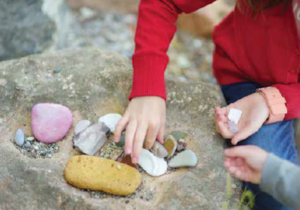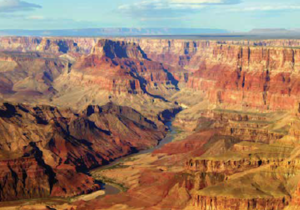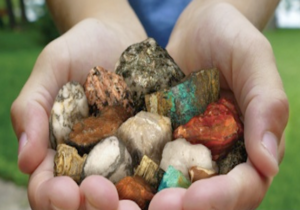Frequently Asked Questions About Rock Collecting
Dan R. Lynch, author of Rock Collecting for Kids, answers five frequently asked questions about rock collecting.
Where to begin?
When you want to begin collecting rocks and minerals, there’s a lot to know first. What tools and safety equipment to bring, when to go looking, and how to stay safe are all very important things to consider.
 Where can I look for rocks and minerals? Is it OK to search for them everywhere?
Where can I look for rocks and minerals? Is it OK to search for them everywhere?
The best part about rock and mineral collecting is that you can find them almost anywhere! As long as you are in a natural space, you can probably find some neat rocks or pretty mineral specimens. Some places are better than others, though. Good places to look include shorelines of lakes and near rivers, in forests, and even along dirt roads. Any place there is moving water can have a lot of rocks to pick up and examine. If you live near a desert, then you already know there are neat rocks all around for you to look at.
And if you live near mountains, ask your parents to take you on a hike to look for rocks on the hillsides! But before you collect anything, keep safety in mind. Wild places can be very dangerous, so be careful and stay with an adult! Never go into moving water (such as rivers) because it can be very fast and sweep you away. And never go near cliffs or big rock piles because they can fall on you!
It is also very important to understand that you are not allowed to collect rocks everywhere. Many places are protected by the state or local government. This includes national parks, many state parks, national monuments, and Native American reservations. It is illegal to collect anything in these places! You also can’t collect on private property without getting permission to do so first. (That’s against the law.)
 If you aren’t sure if you can collect rocks and minerals where you are, always ask an adult to help you find out. To find public land where you can collect rocks legally, check your state’s natural resources agency or department of natural resources. Rock collecting is allowed on some federal land too. Visit the Bureau of Land Management (blm.gov) or the U.S. Forest Service (www.fs.fed.us) for more information. When in doubt, contact a nearby rock shop or a state field guide
If you aren’t sure if you can collect rocks and minerals where you are, always ask an adult to help you find out. To find public land where you can collect rocks legally, check your state’s natural resources agency or department of natural resources. Rock collecting is allowed on some federal land too. Visit the Bureau of Land Management (blm.gov) or the U.S. Forest Service (www.fs.fed.us) for more information. When in doubt, contact a nearby rock shop or a state field guide
for advice.
When is the best time to go rock collecting?
Some times of the day are better for collecting rocks than others. If it’s too early or late in the day, you might not have enough light to see. You also don’t want to go out too late because when it gets dark you won’t be able to find your way back. Midday is good because you’ll have plenty of sunlight and lots of time. But if you live in a desert region, try earlier in the morning, before it gets too hot.
How do I stay safe when rock collecting?
Sometimes going out rock collecting can be an adventure, taking you to faraway places. But whether you are in your backyard or at the beach, you always want to stay safe by following these guidelines: Never, ever go alone. If you get lost or hurt, no one will be there to help you. So always ask an adult to come with you. Always bring a map, a charged smart phone, or a GPS system so that you do not get lost. A smart phone will also let you call for help if you need to. Always bring water to drink. It is very dangerous to be outside all day with no water!
 Storage and labeling is an important part of rock collecting.
Storage and labeling is an important part of rock collecting.
One of the most important parts of starting a rock and mineral collection is keeping it safe and recording where you find each piece. You’ll probably want some kind of box for your collection, and you want to keep your pieces from banging into each other. It’s often best to get a box with little compartments, like a fishing tackle box. This way, each of your specimens can have a safe spot.
However you decide to store your collection, label each piece with exactly where you find the specimen, even if you don’t know what it is yet. The location can help you identify the rock or mineral and can help you learn about the area’s geology. A label with the location is also important to other collectors, if you ever show or trade specimens with other rock hounds! Recording where you find a rock is an essential part of becoming a successful collector and young geologist.
Stay informed about all our books and sign up for our newsletter now!


